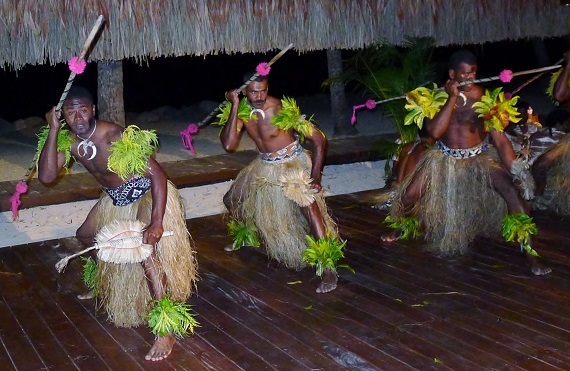
Dancers reenact wars between cannibal tribes.
In the summer of 1867 Methodist missionary Thomas Baker made the history books when he became the last foreigner to be eaten by Fijian cannibals. Baker should have known better - he'd been saving souls on the islands for eight years - but for some reason during a visit to the remote village of Nubutautau he reached out to the chief's head to fiddle with his hair comb. His next (and last) visit was to the tribal stewpot.
Back then, touching the head of a chief - especially a cannibal chief - was a strictly enforced taboo in Fijian culture.
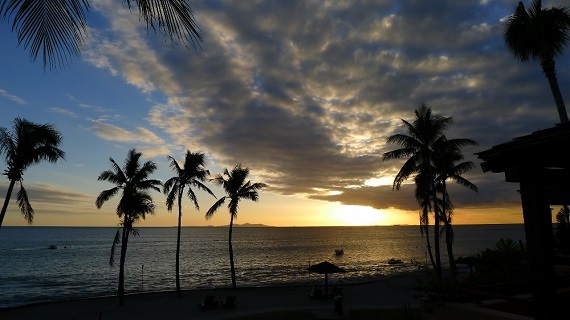
Fiji's sunsets are straight off the travel posters.
Foreign explorers had been avoiding Fiji's 330 islands for hundreds of years. English Captain James Cook, for instance, sailed by there in the 1770s, but he didn't go ashore on what was then called "the Cannibal Islands." Captain Bligh's longboat crew kept rowing past the islands after they were booted off the HMS Bounty in 1789. Bligh noted in his logbook: "I dare not land (on Fiji) for fear of the natives."
Horrific tales of cannibalism helped keep the islands off the bucket lists of all but a handful of the era's gunrunners, whalers, sandalwood traders and escaped convicts from Australia. Likewise, missionaries zeroed in on saving souls elsewhere in the South Seas, such as on New Zealand, New Hebrides (now Vanuatu) and Tonga.
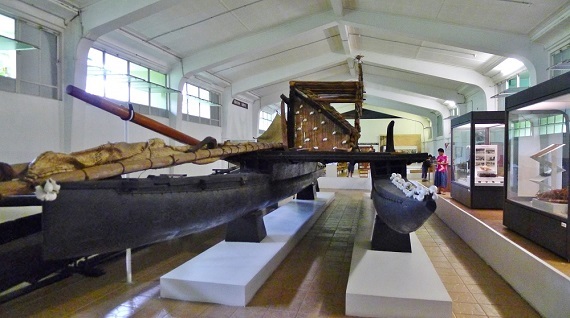
Fierce Fijian warriors once paddled this canoe around the islands.
In the 1830s, stories about the stewpots of Fiji finally brought a tsunami of pastors to the islands from the London Missionary Society. Progress was slow at first, and a good number of soul-savers themselves ended up saved -- for Fijian feasts.
The missionaries' big break came in the 1850s when they were able to convert a super-chief named Ratu Seru Cakobau, and over the next few years (but a bit too late for Baker) most of Fiji. As villagers switched to Christianity, they renounced cannibalism.

Pieces of the soles of Thomas Baker's boots are displayed at the Fiji Museum.
Fast forward to today, and you can see what's left of Baker in a museum in Suva, Fiji's capital. Mosey around the Fiji Museum's old-time dugout canoes, rusting rifles, battle clubs, artworks, masks, musical instruments, history charts and the like, and you'll come across an odd-looking glass case spotlighting what looks like chewed up pieces of bark. Actually, they're nine boiled pieces of the soles of Baker's boots (with teeth marks, no less).
Maybe it was a longstanding touch of guilt, or perhaps because the villagers of Nubutautau had run into hard times, but in 2003 they invited 11 of Thomas Baker's descendants to a traditional Fijian matanigausau ceremony to tell them they were sorry for what happened 136 years earlier.
Nick Squires, a reporter who attended the event for the English news service The Telegraph, wrote: "Tearful Fijian warriors in grass skirts and armed with clubs yesterday begged forgiveness from the descendants of an English missionary their ancestors killed and ate more than a century ago.
"In an elaborate ceremony villagers presented woven mats, a dozen highly-prized whale's teeth and a slaughtered cow to 10 Australian relatives of the Rev Thomas Baker, who was murdered, cooked and consumed while trying to spread Christianity in Fiji's rugged highlands in July 1867."
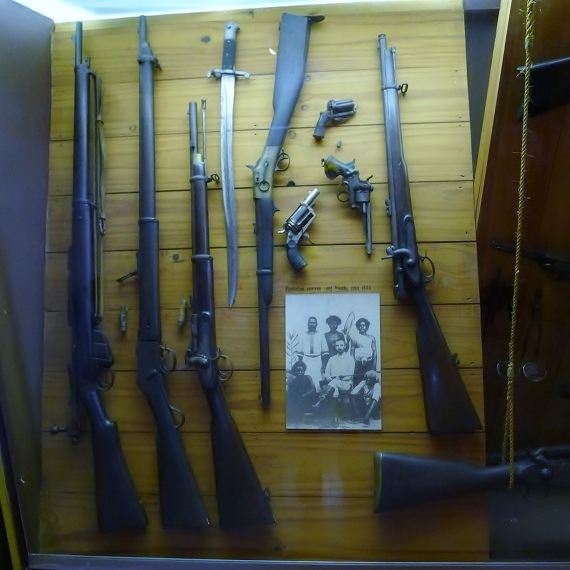
The islands' few settlers came armed to the teeth.
Fijians reportedly trekked from distant villages on foot and horseback to witness the forgiveness ceremony. Also there among 600 onlookers was Fiji's prime minister, Laisenia Qarase, who flew in by helicopter. According to Squires, "Bare-chested men clapped and sang beneath the fierce tropical sun..."
In his story, Squires noted: "Wiping away tears, the chief of the village, Ratu Filimone Nawawabalavu, offered gifts and kissed the cheek of Les Lester, 56, Mr Baker's great-great-grandson." Said the chief: "We believe we must have been cursed, and we must apologize for (eating Baker)... when we have made the apology we will be clean again."
As a roll of thunder sounded across distant ranges, Lester is said to have added: "Perhaps the coming rain is a sign of a new beginning.'"
To seal the apology, the villagers erected a monument in Baker's honor in the center of Nubutautau.
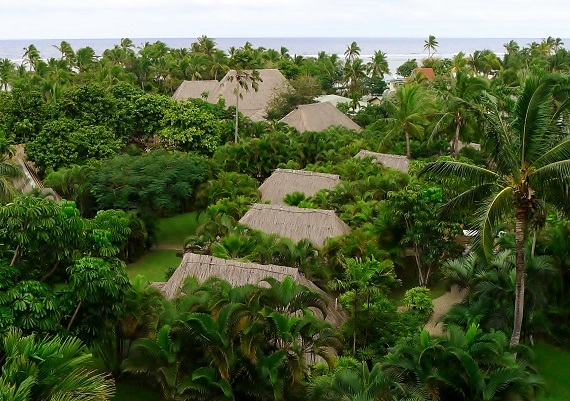
Some vacationers stay in luxury huts at upscale resorts.
Staying there: Fiji's 100 or so inhabited islands host close to 780,000 annual visitors, most of whom stay in 100-plus tourist-class resorts and inns. A hefty number of the properties feature opulent thatched-roof bure huts popping out of the jungle on Viti Levu and on boutique resorts peppering the out islands.
Our 2024 Coverage Needs You
It's Another Trump-Biden Showdown — And We Need Your Help
The Future Of Democracy Is At Stake
Our 2024 Coverage Needs You
Your Loyalty Means The World To Us
As Americans head to the polls in 2024, the very future of our country is at stake. At HuffPost, we believe that a free press is critical to creating well-informed voters. That's why our journalism is free for everyone, even though other newsrooms retreat behind expensive paywalls.
Our journalists will continue to cover the twists and turns during this historic presidential election. With your help, we'll bring you hard-hitting investigations, well-researched analysis and timely takes you can't find elsewhere. Reporting in this current political climate is a responsibility we do not take lightly, and we thank you for your support.
Contribute as little as $2 to keep our news free for all.
Can't afford to donate? Support HuffPost by creating a free account and log in while you read.
The 2024 election is heating up, and women's rights, health care, voting rights, and the very future of democracy are all at stake. Donald Trump will face Joe Biden in the most consequential vote of our time. And HuffPost will be there, covering every twist and turn. America's future hangs in the balance. Would you consider contributing to support our journalism and keep it free for all during this critical season?
HuffPost believes news should be accessible to everyone, regardless of their ability to pay for it. We rely on readers like you to help fund our work. Any contribution you can make — even as little as $2 — goes directly toward supporting the impactful journalism that we will continue to produce this year. Thank you for being part of our story.
Can't afford to donate? Support HuffPost by creating a free account and log in while you read.
It's official: Donald Trump will face Joe Biden this fall in the presidential election. As we face the most consequential presidential election of our time, HuffPost is committed to bringing you up-to-date, accurate news about the 2024 race. While other outlets have retreated behind paywalls, you can trust our news will stay free.
But we can't do it without your help. Reader funding is one of the key ways we support our newsroom. Would you consider making a donation to help fund our news during this critical time? Your contributions are vital to supporting a free press.
Contribute as little as $2 to keep our journalism free and accessible to all.
Can't afford to donate? Support HuffPost by creating a free account and log in while you read.
As Americans head to the polls in 2024, the very future of our country is at stake. At HuffPost, we believe that a free press is critical to creating well-informed voters. That's why our journalism is free for everyone, even though other newsrooms retreat behind expensive paywalls.
Our journalists will continue to cover the twists and turns during this historic presidential election. With your help, we'll bring you hard-hitting investigations, well-researched analysis and timely takes you can't find elsewhere. Reporting in this current political climate is a responsibility we do not take lightly, and we thank you for your support.
Contribute as little as $2 to keep our news free for all.
Can't afford to donate? Support HuffPost by creating a free account and log in while you read.
Dear HuffPost Reader
Thank you for your past contribution to HuffPost. We are sincerely grateful for readers like you who help us ensure that we can keep our journalism free for everyone.
The stakes are high this year, and our 2024 coverage could use continued support. Would you consider becoming a regular HuffPost contributor?
Dear HuffPost Reader
Thank you for your past contribution to HuffPost. We are sincerely grateful for readers like you who help us ensure that we can keep our journalism free for everyone.
The stakes are high this year, and our 2024 coverage could use continued support. If circumstances have changed since you last contributed, we hope you'll consider contributing to HuffPost once more.
Already contributed? Log in to hide these messages.





